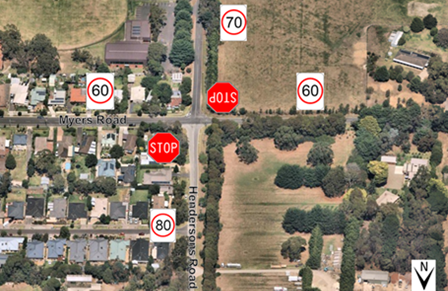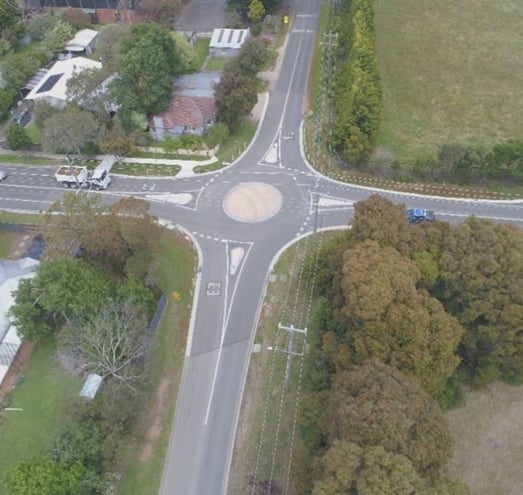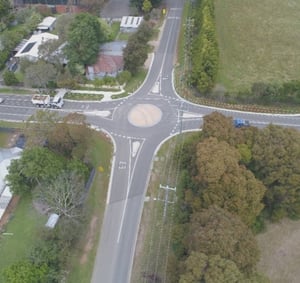Reducing travel speeds across the road network has been challenging. The relationship between impact speed, impact energy and harm in a collision is obvious.
The problem we were asked to solve
Proven innovative intersection treatments are needed to provide cost effective and sustainable risk reduction measures across the network. This case study involves the evaluation of a new, performance-based design, compact roundabout treatment. The study was funded under the Road Safety Innovation Fund (2021-2023) by the Australian Government. The purpose of the evaluation was to demonstrate direct and indirect road safety benefits resulting from the compact roundabout treatment.
The project sought to reveal the effectiveness of the intersection safety treatment (the compact roundabout design) in achieving road safety objectives and technology innovation. Do compact roundabouts present a more cost-effective and sustainable treatment for addressing intersection crashes which are major contributors to road trauma?
Background
Roundabouts embody Safe System principles and are highly effective in reducing fatal and serious injury (FSI) crashes because of the changes in speed and impact angles they generate. To reduce speeds on the approach, the novel compact roundabout design uses speed platforms (vertical deflection) rather than reverse curves (horizontal deflection) which are commonly used in conventional roundabouts. In addition, conventional performance evaluation of safety treatments is typically undertaken using tubes and traffic counters, which although reliable and cost effective can expose field staff to a high degree of risk with laying the tubes on the road. Other technologies are available to capture this data that will also provide opportunities to collect sophisticated and in-depth analysis of road users’ behaviour. For this project, a hybrid model was undertaken that combined conventional tube data with computer vision techniques for evaluating the performance of road user behaviours.
The evaluation was based on Safe System principles, with the aim to establish a baseline for performance behaviour and to prevent selective bias of critical safety metrics. The intersection geometry prior to the treatment works is shown in Figure 1.

Figure 1 Intersection prior to roundabout construction
Source: Mornington Peninsula Council
What we found
The major findings of this study were that, in using vertical deflection rather than changes in horizontal alignment, the compact roundabout was able to achieve changes (reductions) in vehicle speed and kinetic energy profiles highlighting the potential to reduce high levels of injury risk to levels more aligned with Safe System principles.
It was found practical to construct and safely operate a compact roundabout in a higher speed setting. The roundabout showed that the vehicle travel speeds on entry to the cross intersection was reduced and the road user compliance with speed limits had also improved markedly at the intersection.
This project also evaluated a method to systematically compare the traditional evaluation method with novel evaluation technologies. A combination of drone (off-road) and computer vision technology was undertaken and analysed by applying advanced 3-dimensional mapping and machine learning technology.
Benefits
Environmental benefits
Environmental gains were made by using a smaller footprint than a traditional geometric roundabout design, eliminating the need for land acquisition, encroachment of flora and fauna, relocation of utilities, planning approvals and increased construction demolition waste, which are often required to accommodate reverse curves. The environmental benefits can be realised with the reduction in construction time and materials required to construct the compact roundabout.

Figure 2 Compact roundabout construction
Source: Real Time Traffic (2023)
Performance benefits
Using the computer vision technology, the levels of kinetic energy (derived from vehicle speed, mass, and entry angle) in potential collisions were compared before and after installation of the compact roundabout to indicate the injury-reducing benefits.
It was determined that the compact roundabout (Figure 2) not only reduced the approach speed but also decreased the approach angle in a conflict scenario, ultimately, reducing crash severity and serious road trauma.
Cost benefits
Conventional roundabout design methods require a reverse curve on the approach to the roundabout when in higher speed limit environments to reduce entry speed and orient the approaching vehicle for entry to the roundabout.
The compact roundabout design method utilises raised platforms and speed cushions to reduce speeds on the approach to roundabouts. This eliminates the need for a reverse curve on the approach and provides an opportunity to reduce the central island diameter to reduce the construction footprint.
Summary
Reducing travel speeds on the across the road network has been challenging. The relationship between impact speed, impact energy and harm in a collision is obvious.
However, it is the management of impact speeds, and not necessarily the reduction of speed limits, that will have the greatest effect on minimising harm.
The findings of this project indicated that compact roundabouts could deliver safety performance that meet Safe System principles, operate efficiently in common settings, and be constructed in a smaller footprint. Use of compact roundabouts has the potential to make a substantial contribution to the achievement of the National Road Safety Strategy 2021-30 targets and support the long-term goal of Vision Zero.
Additional research and project partners are required to further evaluate the Safe System and performance of compact roundabouts for practitioner confidence.
Video
A video detailing some of the research and explaining the project can be found below.
